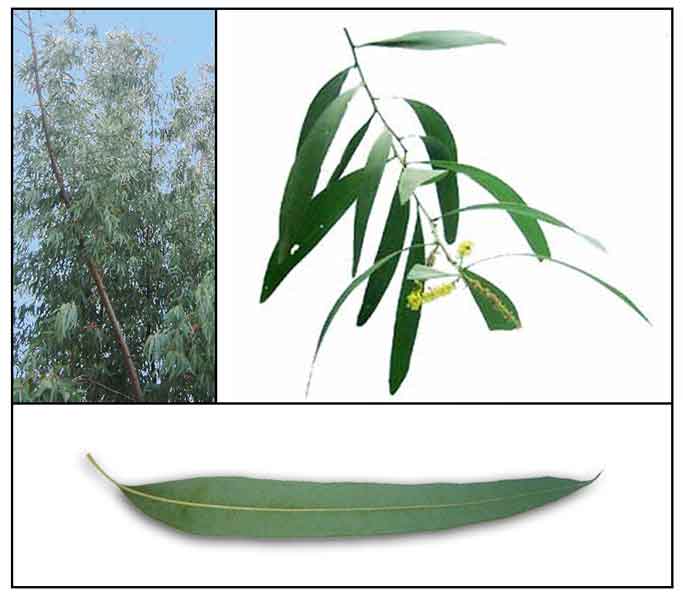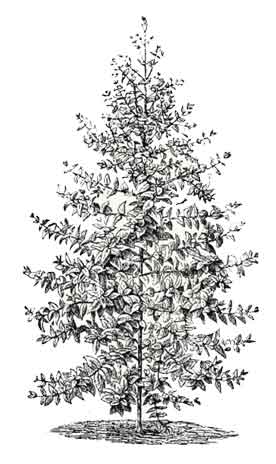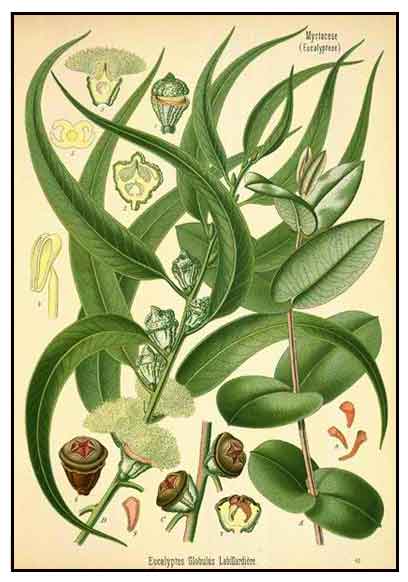|
 Snippets Snippets
- Eucalyptus globulus was discovered in the islands of Tasmania in 1792 by French Explorers.
- Genus Eucalyptus contains about 600 species, and E. globulus is the most widely cultivated in subtropical and Mediterranean regions. (26)
- The genus name Eucalyptus comes from the Greek word eukalyptos, meaning "well-covered", referring to the flowers, when in bud, are covered with a cup-like membrane that is shed when the flower expands. (26)
Botany
Eucalyptus is an evergreen tree that reaches a height of 15 meters or more. Bark is grayish, peeling off in thin, long strips, whitish gray underneath. Young leaves are cordate, glaucous-blue, and clasping the stem. Mature leaves are leathery, lanceolate, dark green, usually somewhat sickle-shaped, more than 30 centimeters long. Flowers are white, about 1.5 centimeters in diameter, becoming fragrat as they mature. Fruit is obovoid or somewhat rounded, about 8 millimeters in diameter.
 Distribution Distribution
- Usually planted as a garden
plant in Baguio and Manila.
- Grows vigorously in the Baguio area.
- Native to Australia.
- Also in North and South Africa, India, and southern Europe.
Constituents
• Yields a volatile oil,
0.01 - 1.96% - cineol, 80%, d-alpha pinene, camphene, fenchene, butyric
and caprionic aldehydes, ethyl and iso-amyl alcohols, acetic acid, cymol,
sesquiterpene, eudesmos, 1-pinocarveol.
• Of the more than 300 species, the species with the highest
yield of eucalyptus oil are E. globosus, E. tereticornis, E. polyanthemos
and E. citriodora.
• Leaves, buds, branches and bark yield taxifolin and eriodictyol.
• Study of essential oil yielded 53 oil components:1,8-cineole, a-pinene, limonene, aromadendrene, delta-cadinene, and globulol were the most abundant compounds, representing 93% of the total oil.
• Study of fruits yielded 15 compounds: beta-sitosterol, betulinic acid, stigmasterol, euscaphic acid, 2a-Hydroxybetulinic acid, macrocarpal B, macrocarpal A, oleanolic acid, 3,4,3'-O-trimethylellagic acid, 3-O-methylellagic acid 4'-O-(2"-O-acetyl )-alpha-L-rhamnopyranoside, camaldulenside (cypellocarpin C, 3-O-methylellagic acid 4'-O-alpha-L-rhamnopyranoside, 3-O-methylellagic acid, ellagic acid, and gallic acid.
• Study leaf essential oil yielded forty-seven compounds with the main constituents of 1, 8-eucalyptol (72.71 %), α-pinene (9.22 %), α-terpineol (2.54 %), (-)-globulol (2.77 %), α-terpineol acetate (3.11 %), and alloaromadendrene (2.47 %).(19)
• Isolation of water-distilled
volatile oil from leaves of E. globulus consisted mainly of oxygenated monoterpenes, monoterpenes, and oxygenated sesquiterpenes. The main oxygenated monoterpene were 1,8-eucalyptol (72.71%), a-terpineol (2.54%), terpinen-4-ol (0.34%), and linalool (0.24%). Main monoterpenes were a-pinene (9.22%), and ß-pinene (0.4%) while the main sesquiterpenes were a-eudesmol (0.39%), (-)-globulol (2.77%), and epiglobulol (0.44%). (23)
Properties
• Oils are in classified into: (1) medicinal, containing eucalytol
or cineol (2) industrial, containing terpenes, used in mining operations,
and (3) aromatic, as in E. citriodora.
• Considered anesthetic, antibronchitic, antiseptic, anticatarrh, antiparasitic, antirheumatic, antispasmodic, antiviral, cooling, antiinflammatory, diuretic,
febrifuge, rubefacient, analgesic, insect
repellent, sedative, expectorant, stimulant.
Parts used
Mature leaves, oil.
 Uses Uses
Edibility
- Blue gum leaves used as therapeutic herbal tea.
- Leaves are used as food additives.
Folkloric
- As antiseptic and deodorant, leaves are crushed and applied on affected areas.
- Decoction of leaves as tea for cough, asthma, hoarseness, fevers.
- Pure eucalyptus oil, two drops in a tsp of warm water, for coughs, whooping
coughs, asthma and bronchitis.
- Infusion of leaves used for asthma, catarrh, bronchitis, whooping cough,
coryza, dysentery, diabetes, fevers and colds, malaria, rhinitis, tuberculosis.
- For sinusitis, breathing of vapor of decoction of leaves.
- Decoction of leaves used for washing and cleaning wounds.
- Other uses: Diabetes, lumbago, sciatica, toothaches, tuberculosis, dysentery,
gout.
- In China, used for promote eschar formation.
- In France, leaf extract used as hypoglycemic.
- In Guatemala, leaf decoction for fever.
Hot water extract of dried leaf used for ringworm, wounds, ulcers, pimples
and as vaginal douche.
- In India, as mosquito repellent and insecticide.
- In Italy, as inhalation therapy for asthma;
also for diabetes.
- In Kenya, for snail infestation.
- In Mexico, for urethritis, laryngitis,
cystitis, gastritis, enteritis; as antipyretic and antimalarial.
- In Tunisia, for bronchial conditions and
cough.
- In Spain, for colds, catarrh, diabetes.
- Aborigines of Australia traditionally use the leaves for wound healing and fungal infections. (25)
Preparation for use: Gather the leaves, dry in the sun for 5-6
hours. Place in a paper bag, tie and hang in the shade for a week. Decoct
50 gms of the dried leaves in a pint of boiling water; drink 6 glasses
daily. For fresh leaves, use 60 to 70 gms to a pint of boiling water,
drink the same amount.
Livestock
• Mastitis: A herbal gel made from C longa, Cedrus deodara, G glabra and E globulus, applied twice daily, is used to treat and prevent subclinical mastitis in crossbred cows.
• Bovine endometriosis: Cow with endometritis were given an intrauterine infusion of a 10% solution of a tincture of E globulus.
• Ectoparasites: Two experimental herbal mixtures containing E globulus along with several other plant oils have been used on dogs to treat ectoparasites.
Other
- Apiculture: Flowers are a source of nectar. The honey as a distinctive flavor of muscatel grapes. (27)
- Biopesticidal: Leaves burned for use as Insect repellant. Extract used to kill fleas.
- Timber: Wood is hard and strong, but seasons poorly, difficult to work with and nail but gives a high finish. Used for light construction, plywood, utility poles, tool handles, for making parquet and low-grade veneer. (27)
- Perfumery / Cosmetic: Oil used in perfumery. Extracts used in cosmetic formulations.
- Pharmaceutical component: In both the United States and Germany, eucalyptus oil is used extensively as an expectorant component of cough and cold compounds, in various forms such as lozenges, syrups, and as vaporized inhalant. (26)
- Commission E: CommE has approved the internal use of eucalyptus oil for catarrhs of the respiratory tract and externally for rheumatic complains. (26)
- Fiber / Paper: E. globulus is one of the better Eucalyptus species for papermaking and is widely used as pulp. The pulp is used in making fiberboards and particleboard. (27)
- Fuel: Makes a good firewood with an over-dry calorific value of 18,000 kJ/kg, burns freely with little residual ash, and carbonized easily for good characoal. (27)
Extraction
of oil
Boil mature leaves in water,
condensing the vapor to recover the oil. Eucalyptus globulus yields
less oil than the other varieties used for commercial production of
medicinal grade oils.
Studies
• Antibacterial: Study investigated the antibacterial activity of three medicinal
plants: Eucalyptus globulus, Aristolochial latas and Vitex negundo against
enteric pathogens. Results
showed varying degrees of antibacterial activity with the maximum zone
of inhibition obtained with E. globulus. (3)
• Antihyperglycemic: In the study, incorporation of eucalyptus in the diet and drinking water reduced hyperglycemia and associated weight loss of STZ-treated mice. The study showed
pancreatic protection or regeneration following exposure to streptozotocin. Data indicate E globulus represents an effective antihyperglycemic dietary adjunct for the treatment of diabetes. (4)
• Antibacterial / Leaf Essential Oils: Antibacterial
activity of leaf essential oils of Eucalyptus globulus and Eucalyptus
camaldulensis: Study
suggested the potential usefulness of the two Eucalyptus species as
a micobiostatis, antiseptic or as a disinfectant agent. (5)
• Chemical Constituents of Fruit: Five compounds were isolated from the fruit: betulonic acid, betulinic acid, ursolic acid, corosolic acid and daucosterol. (6)
• Acaricidal: Study on the acaricidal effects of the essential oils of two medicinal plants – Pelargonium roseum and E globulus – showed a dose-dependent effect on mortality rate for adult ticks and mass of egg production. Results showed both plants can be considered as potential candidates for the biocontrol of R annulatus in the field. (8)
• Antioxidant / Anti-Diabetic: Study results conclude that eucalyptus possess antioxidant and antidiabetic activities. Data indicated eucalyptus either increase antioxidant power or reduce oxidative stress due to reduction in plasma glucose in diabetic rats, which prevents excessive production of free radicals through glycation of proteins. (9)
• Antibacterial / Leaves: Study evaluated the antibacterial activity of E globulus leaf extract on 56 isolates of Staphylococcus aureus, 25 isolates of Streptococcus pyogenes, 12 isolates of Streptococcus pneumoniae and seven isolates of Hemophilus influenza from 200 clinical specimens of patients with respiratory tract disorders. MIC50s were 64, 32, 16, and 16 mg/mL, respectively; MIC90s were 128, 64, 32, and 32 mg/L, respectively, and MBCs were 512, 128, 64, and 64 mg/L, respectively. (10)
• Antioxidant / Food Dye: Study showed the SCF (superficial fluid extract), methanolic and water extracts of the stem bark possess similar free radical scavenging and antioxidative activity higher than synthetic antioxidants BHT. The SCF extract also showed to be a good source of yellow natural food dye. (11)
• Antidiabetic / Restoration of Pancreatic Islets: Study evaluated the effects of eucalyptus leaves on STZ-induced damage in pancreatic islets. Results suggest EG caused dose-dependent amelioration of the diabetic state by partial restoration of pancreatic beta cells and repair STZ-induced damage in rats. (12)
• Hepatotoxicity / Leaves: Study of aqueous extract of E. globulus leaves on biochemical parameters of rat liver showed deleterious effects on liver membrane and functional integrity. Repeated administration produced a significant increase in ALP in a dose-dependent manner. Mechanism may be due to enzyme induction by the extract. Results suggest the aqueous extract of leaves, despite its antidiabetic efficacy, may have deleteerious effect when administered repetitively. (13)
• Eucalyptone / Antibacterial: Study of an ethyl acetate bark fraction of small twigs isolated a new pholoroglucinol, eucalyptone G, together with nine other known compounds. Eucalyptone G exhibited antibacterial activity against Bacillus subtilis, Staphylococcus aureus and E coli. (14)
• Antiplasmodial / Antibacterial: In a study for antiplasmodial activity and cytotoxicity of eleven extracts prepared from seven selected plants in Western Cameroon, seven extracts from five different plants, including E globulus leaves showed activity with weak or no toxicity. E. globulus also had the highest extraction yield. (17)
• Antifungal / Treatment of Candidiasis / Antidiabetic: Study evaluated the leaves of E. globulus for treatment of established systemic infection with Candida albicans in normal and streptozotocin-induced diabetic rats. Eucalyptus administration significantly improved hyperglycemia, polydipsia, polyphagia and also significantly reduced Candida albicans concentration in liver and kidney homogenates. (18)
• Drug Interactions: Moderate: (1) Medications changed by the liver (Cytocrhome P450 1A2 [CYP1A2] substrates interact with eucalyptus. Taking eucalyptus oil with some medications (amitriptyline, haloperidol, ondansetron, propranolol, theophylline, verapamil, etc) can increase the effects and side effects of those medications. (2) Mediciations change by the liver (Cytochrome P450 2C19 substrates interactions with eucalyptus. Taking eucalyptus oil can increased the effects and side effects of some medications, such as omeprazole, lansoprazole, diazepam, carisoprodol, nelfinavir, among others. (3) Medications change by liver Cytochrome P450 2C9 substrates interacts with eucalyptus, with decrease rate of breakdown of some medications, such as diclofenac, ibuprofen, meloxicam, piroxicam, celecoxib, amitriptyline, warfarin, glipizide, losartan, among others. (4) Medications affected by liver (Cytochrome P450 3A4 substrates may decrease how quickly some medications are broken down, such as lovastatin, ketoconazole, itraconazole, fexofenadine, triazolam, among others. (5) Eucalyptus leaf extract may decreased blood sugar and may augment the glucose lowering effect of antidiabetic drugs, such as glimepiride, glyburide, insulin, pioglitazone, rosiglitazone, chlorpropamide, glipizide, tolbutamide, among others. (21)
• Antibacterial / Essential Oil of Leaves: Hydrodistillation obtained essential oils from leaves of the plant. The essential oil showed antimicrobial activity against Gram-negative E. coli and Gram-positive S. aureus. (22)
• Analgesic / Anti-Inflammatory / Essential Oil: Study evaluated the analgesic and anti-inflammatory effects of essential oil extracts from three species of Eucalyptus (E. citriodora, E. teretocornis, and E. globulus). Using acetic acid-induced writhes in mice and hot plate thermal stimulation in rats, results showed all three induced analgesic effects inn both models, suggesting both peripheral and central actions. All three species also exhibited anti-inflammatory effects as evidenced by inhibition of rat paw edema induced by carrageenan and dextran, neutrophil into peritonela cavities induced by carrageenan, and vascular permeability induced by carrageenan and histamine. (24)
• Comparative Antimicrobial Activity / Xylitol, Papain and Essential Oil / Pilot Study: Study evaluated the in vitro antimicrobial activity of E. globulus essential oil, xylitol and papain against P. aeruginosa, Salmonella sp., S. aureus, P. vulgaris, E. coli and C. albicans. Chlorhexidine 0.5% was used as control. E. globulus EO showed higher inhibition than chlorhexidine against S. aureus and equal inhibition to E. coli, P. vulgaris, and C. albicans. Papain 10% showed lower antimicrobial effect than chlorhexidine in relation to C. albicans; xylitol showed no inhibitory effect on tested organisms. (25)
Availability
- Wild-crafted.
- Essential oil, ointments, tinctures, lozenges in the cybermarket.
|


![]()

